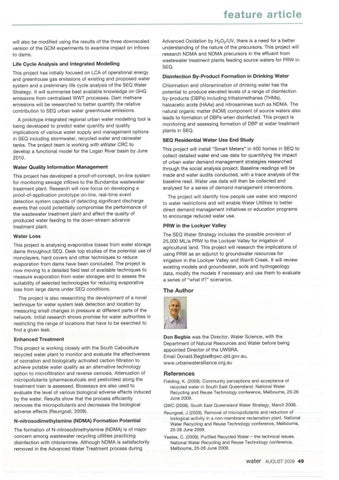feature article will also be modified using the results of the three downscaled version of the GCM experiments to examine impact on inflows to dams.
Life Cycle Analysis and Integrated Modelling Th is project has initially focused on LCA of operational energy and greenhouse gas emissions of existing and proposed water system and a preliminary life cycle analysis of the SEQ Water Strategy. It will summarise best available knowledge on GHG emissions from centralised WWT processes. Dam methane emissions will be researched to better quantify the relative contribution to SEQ urban water greenhouse emissions. A prototype integrated regional urban water modelling tool is being developed to predict water quantity and quality implications of various water supply and management options in SEQ including stormwat er, recycled water and rainwater tan ks. The project t eam is working with eWater CRC to develop a fun ctional model for the Logan River basin by June
2010. Water Quality Information Management Th is project has developed a proof-of-concept, on-line system for monitoring sewage inflows to the Bundamba wastewater treatment plant. Research will now focus on developing a proof-of-application prototype on-line, real-time event detection syst em capable of detecting significant discharge event s that could potentially compromise the performance of the wastewater treatment plant and affect the quality of produced wat er feeding to the down-stream advance treatment plant.
Water Loss This project is analysing evaporative losses from water storage dams throughout SEQ. Desk top studies of the potential use of monolayers, hard covers and other techniques to reduce evaporation from dams have been concluded. The project is now moving to a detailed field test of avail able techn iques to measure evaporation from water storages and to assess the suitability of selected technologies for reduc ing evaporative loss from large dams under SEQ conditions.
Advanced Oxidation by H20 2/UV, there is a need for a better understanding of the nature of the precursors. This project will research NDMA and NDMA precursors in the effluent from wastewater treatment plants feeding source waters for PRW in SEQ.
Disinfection By-Product Formation in Drinking Water Chlorination and chloramination of drinking water has the potential to produce elevated levels of a range of disinfection by-products (DBPs) including trihalomethanes (THMs), haloacetic acids (HAAs) and nitrosamines such as NDMA. The natural organic matter (NOM) component of source wat ers also leads to formation of DBPs when disinfected. This project is monitoring and assessing formation of DBP at water treatm ent plants in SEQ.
SEQ Residential Water Use End Study This project will install "Smart Meters" in 400 homes in SEQ to collect detailed water end use data for quantifying the impact of urban water demand management strategies researched through the social analysis project. Baseline readings will be made and water audits conducted, with a trace analysis of the baseline read. Water use data will then be collect ed and analysed for a series of demand management int erventions. The project wil l identify how people use water and respond to water restrictions and will enable Water Utilities to better direct demand management initiatives or education programs t o encourage reduced water use.
PRW in the Lockyer Valley The SEQ Water Strategy includes the possible provision of 25,000 MUa PRW to the Lockyer Valley for irrigation of agricultural land. This project w ill research the implications of using PRW as an adjunct to groundwater resources for irrigation in the Lockyer Valley and Warri ll Creek. It will review existing models and groundwater, soils and hyd rogeology data, modify the models if necessary and use th em to evaluate a series of "what if?" scenarios.
The Author
The project is also researching the development of a novel technique for water system leak detection and location by measuring small changes in pressure at different parts of the network. Initial research shows promise for water authorities in restricting the range of locations that have to be searched to find a given leak.
Enhanced Treatment This project is working closely with the South Caboolture recycled water plant to monitor and evaluate the effectiveness of ozonation and biologically activated carbon filtration to achieve potable water quality as an alternative tech nology option to microfiltration and reverse osmosis. Attenuation of micropollutants (pharmaceuticals and pesticides) along the treatment train is assessed. Bioassays are also used to evaluate the level of various biological adverse effects induced by the water. Result s show that the process efficiently removes the micropollutants and decreases the biological adverse effects (Reungoat, 2009).
N-nitrosodimethylamine (NOMA) Formation Potential The formation of N-nitrosodimethylamine (NDMA) is of major concern among wastewater recycling utilities practicing disinfection with ch loramines. Although NDMA is satisfactorily removed in the Advanced Water Treatment process during
Don Begbie was the Director, Water Science, with the Department of Natural Resources and Water before being appointed Director of the UWSRA. Email Donald.Begbie@qwc.qld.gov.au, www.urbanwateral liance.org.au
References Fielding, K. (2009). Community perceptions and acceptance of recycled water in South East Queensland. National Water Recycling and Reuse Technology conference, Melbourne, 25-26 June 2009. QWC (2008). South East Queensland Water Strategy, March 2008. Reungoat, J (2009}. Removal of micropollutants and reduction of biological activity in a non-membrane reclamation plant. National Water Recycling and Reuse Technology conference, Melbourne, 25-26 June 2009. Yeates, C. (2009). Purified Recycled Water - the technical issues. National Water Recycling and Reuse Technology conference, Melbourne, 25-26 June 2009.
water AUGUST 2009 49
